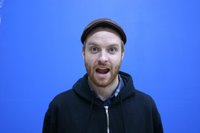Particulars Of the Film; Technical, Etc.
Technique: This film is to be made in the medium of stop-motion animation; a technique whereby we pose little dolls in little sets and dollhouses and move them around to make them look as if they're moving. Whenever I hear somebody bring up stop-motion animation, they usually comment on how slow the process is. Not really. And, we don't have to deal with actors.
Projected length: 12 minutes, not less than ten, not more than 15.
Frame rate for animation: we'll be shooting almost always on 'two's', i.e. two frames taken for every pose. In video, that translates to fifteen frames a second as opposed to the usual 24 for frame. This means that our animation is a little more chunky, but we can work faster, and we're used to it. On tracking shots without characters in them, we'll do a higher frame rate, probably 24 frames a second or something.
Filming medium: high-res digital still photography (courtesey of Dave's Canon Digital Rebel) that is: Edited with Photoshop (color correction, etc.), composited with other elements via After Affects, compiled into digital video via some other peice of nerd software, and then outputed in some high-res HD crap. This is more nerd territory, which our nerds handle.
Projected Completion date: years. Maybe two, probably three.
What we've done so far
An awful lot of preproduction, namely very extensive storyboarding, set design, story rewrites, character design, etc. The majority of planned shots in our movie have been drawn out in large 'presentation' style storyboards, that are detailed enough to researched enough to serve as concept sketches for set design. These boards have been scanned and compiled into an .avi file, that we can review and replace with actual footage as we go. Dave has done a bunch of tests with Maya, which we plan to use for some subtle CG effects. Mike has been editing a YTV show in Montreal, honing his chops.
In terms of concrete progress, we've done the following: aquired 300 square feet worth of industrial warehouse space in Steveston (South Richmond, BC), set up a studio with a woodshop and workbench, and most importantly, almost completed a key set. I will discuss this set in the following post.
I guess this concludes the introduction - all following posts will be of a 'progress report' nature.
 THE CARRIAGE
THE CARRIAGE















